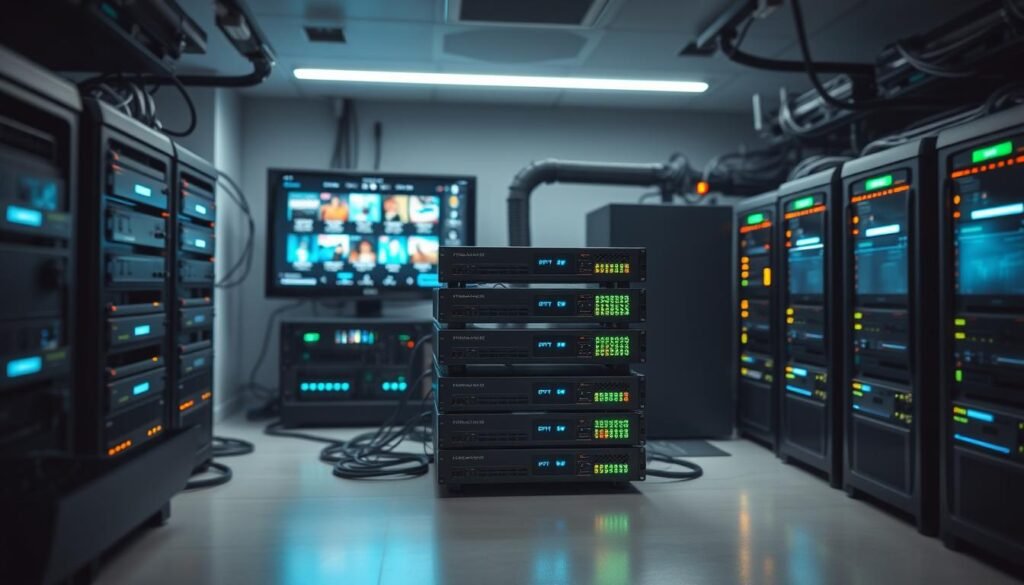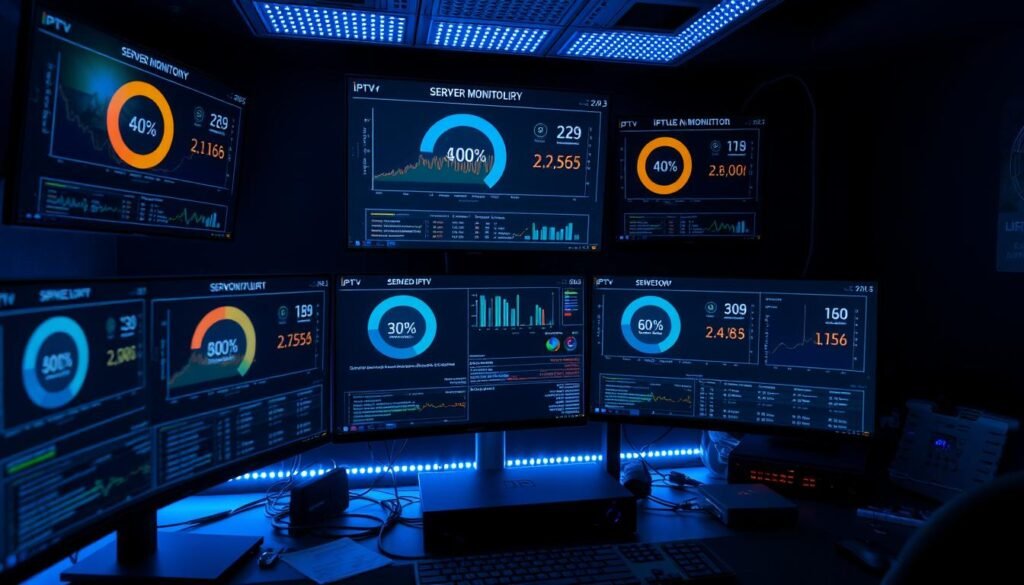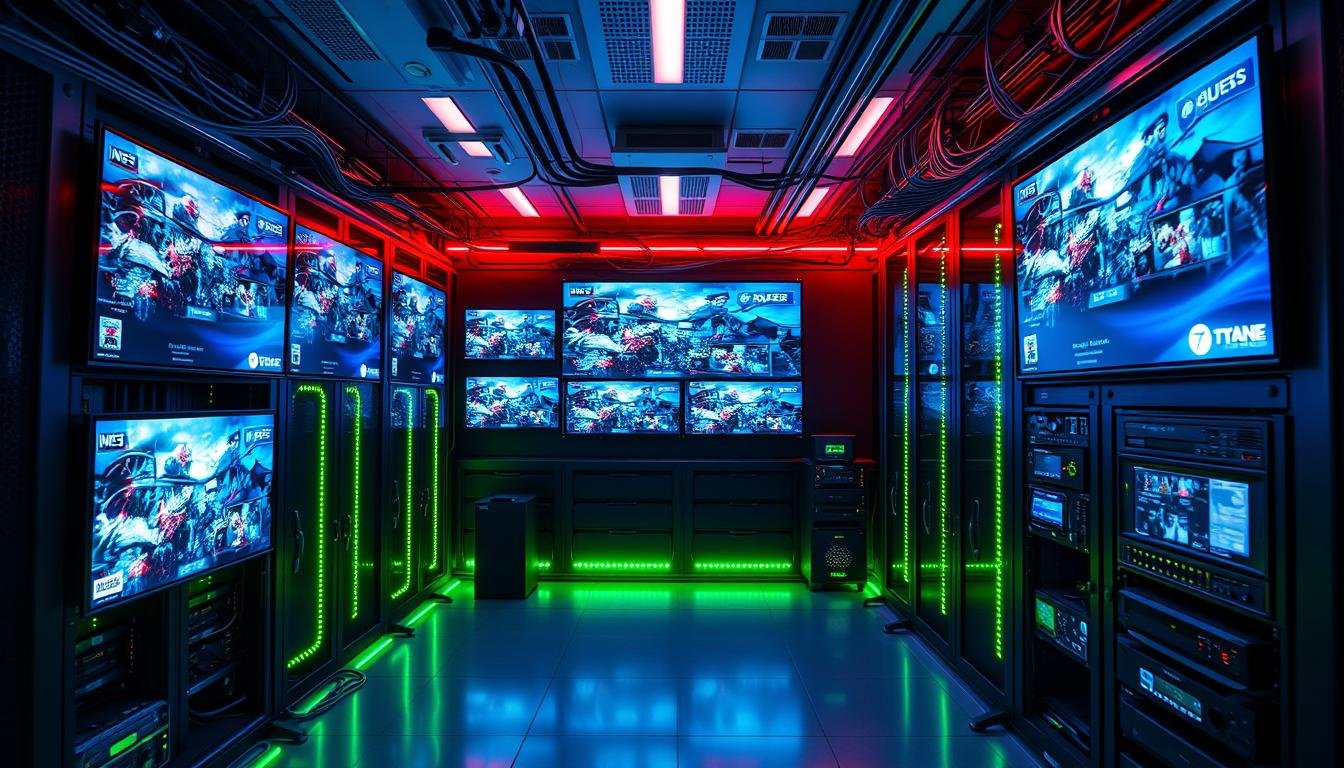In today’s digital world, people want streaming solutions that fit their needs. Internet Protocol Television (IPTV) lets users enjoy content their way. Whether you love media, create it, or run a business, setting up a private IPTV server is rewarding. This guide will show you how to create your own IPTV server for a custom streaming experience.
Want a personal entertainment hub, a special IPTV service, or to explore new tech? This guide has everything you need. We’ll cover IPTV basics, choosing the right gear, setting up your server, and making sure users have a great experience. You’ll learn to create a custom IPTV solution that meets your needs.
Key Takeaways
- Understand the fundamentals of IPTV and its benefits
- Identify the essential hardware and software components for setting up a private IPTV server
- Learn how to configure the server, manage user access, and optimise the streaming experience
- Explore legal considerations and best practices for maintaining a secure and compliant IPTV service
- Discover ways to enhance your IPTV offering and stay ahead of industry trends
Understanding IPTV and Its Benefits
In today’s world, traditional TV is being replaced by new digital options. IPTV Streaming Server technology is leading this change. IPTV, or Internet Protocol Television, delivers TV content over the Internet. It gives viewers a custom and flexible way to watch TV.
What is IPTV?
IPTV uses the Internet to send TV shows and multimedia content to devices. This includes smart TVs, set-top boxes, and mobile devices. Unlike old TV methods, IPTV lets users watch what they want, when they want. They can pause, rewind, and even record live TV.
Advantages of Using IPTV
Bespoke IPTV Server solutions have many benefits. These include:
- Personalized content: IPTV lets users pick their favourite channels and shows.
- Flexibility and portability: IPTV can be watched anywhere with an Internet connection.
- Cost-effectiveness: IPTV is often cheaper than traditional TV services.
- Enhanced viewing quality: IPTV offers high-definition and 4K content for a better viewing experience.
Types of IPTV Services
IPTV offers different services to meet various viewer needs. Some common types include:
- Video on Demand (VOD): Users can watch a huge library of movies and TV shows whenever they want.
- Live TV: IPTV streams live TV channels, so viewers can watch events and news as they happen.
- Time-Shifted Media: This feature lets users pause, rewind, and record live TV, giving them more control.
As IPTV technology improves, it will offer even more benefits. It’s changing how we watch TV, making it more convenient and personal.
“IPTV is not the future of television; it is the present. The convenience, personalisation, and cost-effectiveness it offers are already revolutionising the way we watch TV.”
Choosing the Right Equipment for Your IPTV Server
Building a strong IPTV server needs the right hardware and software. Whether you’re making a Self-Hosted IPTV Platform or a Secure IPTV Infrastructure, the right tools are key. They ensure a smooth streaming experience for your users.
Essential Hardware Components
You’ll need a strong server or a dedicated appliance at the heart of your IPTV server. It should have a fast processor, lots of RAM, and enough storage for your content. You might also need a top-notch network card and a stable internet connection, depending on your users and stream quality.
Recommended Software for Streaming
Choosing the right software is crucial for your IPTV server. Options like Plex, Emby, and Jellyfin are great for managing content and streams. Or, you could go for a commercial platform like Wowza or Nimble Streamer for more advanced tools.
Setting Up Network Infrastructure
A solid network is vital for your IPTV server. Make sure your router and switches can handle the bandwidth of your streams. Using Quality of Service (QoS) can help keep IPTV traffic smooth. Also, setting up a VPN can make your Secure IPTV Infrastructure even stronger.
By picking the best hardware, software, and network, you can build a reliable Self-Hosted IPTV Platform. It will give your users a top-notch streaming experience.
Selecting a Streaming Platform
Choosing the right streaming platform is key when setting up a Private IPTV server. You can either host it yourself or use a third-party service. Each choice has its own benefits, depending on your project’s needs and resources.
Self-Hosted vs. Third-Party Solutions
Self-hosting gives you full control and customisation. It’s best for big organisations or those with technical skills. Third-party services, like Private IPTV Hosting or Dedicated IPTV Server Solutions, are easier to use. They handle server and software upkeep for you.
Popular IPTV Software Options
There are many IPTV software options to choose from. Plex, Emby, and Jellyfin are well-known for their features and ease of use. They offer a simple interface, tools for managing content, and work well with different devices.
Integrating with Existing Systems
It’s crucial to pick a platform that fits with your organisation’s systems. Good integration makes things easier for users and improves content delivery. Look for solutions with strong APIs, single sign-on, and media library syncing.
By carefully choosing the right option for your needs, you can set up a successful Private IPTV server. This is true whether you host it yourself or use a third-party service.
Preparing Your Content Library
Creating a Private IPTV Server or IPTV Streaming Server needs a well-organised content library. This step is key to giving your viewers a wide range of top-quality shows. It makes their viewing experience better.
Sourcing Legal Content
It’s vital to make sure all media on your library is legal. This protects your IPTV service from legal trouble and keeps your platform honest. Work with trusted content providers, get the right licenses, and keep up with copyright laws. This way, your Private IPTV Server stays legal and reliable.
Organising Your Media Files
Having a good system for your media files is crucial for a smooth IPTV Streaming Server. Create a clear structure for your files so users can easily find what they want. Organise your content by genre, channel, or other useful categories. This makes your library easy to use.
Ensuring High-Quality Streams
It’s important to give your viewers high-quality streams all the time. Make sure your media files stream well by adjusting bitrate, resolution, and codec. Keep an eye on your streams and fix any quality issues. This ensures your viewers have a great time watching.

“Building a comprehensive content library is the foundation for a thriving IPTV Streaming Server. Attention to legal compliance, effective file organisation, and high-quality streams will set your platform up for success.”
Configuring the IPTV Server
Setting up your Customised IPTV Solution or Self-Hosted IPTV Platform is key to a great private IPTV server. We’ll show you how to set it up for the best performance and user experience.
Initial Software Setup
The first thing is to install and set up the right software. Choose the right streaming platform and media server. Make sure everything works well together. Always follow the instructions and test each part to find and fix any problems.
Configuring Stream Settings
- Change the bitrate and resolution of your video streams for high-quality playback without slowing down the server.
- Set up the audio settings for a better listening experience for your users.
- Optimise the content delivery network (CDN) to reduce latency and ensure smooth streaming.
User Management and Permissions
- Create user accounts and set access levels to control who can view and manage your IPTV content.
- Use authentication methods like username and password or multi-factor authentication to keep your Customised IPTV Solution secure.
- Check and update user permissions regularly to keep control over your Self-Hosted IPTV Platform.
By carefully setting up your IPTV server, you can give your users a smooth and reliable viewing experience. You’ll also keep your Customised IPTV Solution or Self-Hosted IPTV Platform secure and safe.
Setting Up User Access and Authentication
Building a Secure IPTV Infrastructure for your private server is all about user access and authentication. You need to create user accounts and use strong authentication methods. This way, only those who are allowed can get into your Bespoke IPTV Server and watch its content.
Creating User Accounts
First, you must set up individual user accounts. This lets you control who can use your IPTV server and what they can do. Here are some tips for setting up user accounts:
- Give each user a unique username and a strong, safe password.
- Use multi-factor authentication, like two-step verification, for extra security.
- Give users different permissions and access levels based on their roles.
Authentication Methods
Choosing the right way to authenticate users is key for a private IPTV server that’s secure. Here are some common methods:
- Use usernames and passwords.
- Try two-factor authentication, like SMS or email verification.
- Link your server to identity management systems, like Active Directory or LDAP.
Managing User Permissions
To keep your Bespoke IPTV Server safe and only accessible to those who should be there, managing user permissions is crucial. This means:
- Creating different user roles with their own access levels (like admin, regular user, or guest).
- Letting each role do what it needs to, like manage content, change settings, or watch certain channels.
- Checking and updating user permissions often to match changes in user roles or needs.
With a solid system for user access and authentication, you can protect your private IPTV server. This ensures only the right people can watch your media and streaming services.
Testing Your IPTV Server
It’s vital to make sure your Private IPTV Hosting and IPTV Streaming Server work well. This ensures your users get a smooth and reliable viewing experience. We’ll show you how to do thorough tests, fix common problems, and check the quality to make sure your IPTV server is top-notch.
Conducting Functional Tests
First, test the main parts of your IPTV server. Check if all channels and on-demand content are working, the EPG is right, and streaming is smooth. Use different devices like smart TVs, set-top boxes, and mobiles to make sure everyone has a great experience.
Troubleshooting Common Issues
You might run into some problems during testing. Be ready to quickly fix issues like connection problems, wrong channel settings, or login errors. Keep detailed logs and work with your team to find and fix these problems. This will keep your IPTV Streaming Server running smoothly.
Quality Assurance Checks
Do more than just test the basics. Check the video and audio quality, make sure subtitles and closed captions work, and that the interface is easy to use. Get feedback from many users to find ways to improve. Keep making your IPTV server better to meet your audience’s changing needs.

By following these steps, you can be sure your Private IPTV Hosting and IPTV Streaming Server are ready. They will give your users an amazing, reliable, and fun viewing experience.
Best Practices for Maintaining Your IPTV Server
Keeping your Dedicated IPTV Server Solutions running smoothly is key. It ensures a secure IPTV infrastructure for your users. By following best practices, you can reduce downtime and improve the user experience. This also protects your valuable content library.
Regular Software Updates
It’s vital to keep your IPTV server software up-to-date. Regularly update your system with the latest patches and versions. This keeps your server stable, secure, and adds new features.
Monitoring Server Performance
Monitoring your Dedicated IPTV Server Solutions is crucial. Use server monitoring tools to track important metrics. This helps you spot and fix issues quickly, ensuring a smooth streaming experience for your users.
Backup and Recovery Procedures
Having strong backup and recovery plans is essential. Regularly back up your server’s data to a safe place. This way, you can quickly recover in case of a problem, reducing downtime and data loss.
By following these best practices, you can keep your Dedicated IPTV Server Solutions stable and secure. This ensures a reliable viewing experience for your users.
“Proactive maintenance is the key to ensuring the longevity and reliability of your IPTV server infrastructure.”
Enhancing Your IPTV Experience
Starting your journey with a Customised IPTV Solution or Bespoke IPTV Server is exciting. It’s all about making your viewing experience better. You can personalise your interface and add more content to meet your audience’s needs.
Personalising User Interfaces
A great IPTV experience comes from a user interface that fits your viewers’ tastes. Use your Customised IPTV Solution or Bespoke IPTV Server to let users change their dashboards and favourite channels. This makes your platform more engaging and satisfying for users.
Adding Additional Features
Think about adding features that go beyond just streaming. DVR functionality lets viewers record and watch shows later. Smart home controls or voice interfaces can also make your IPTV easier to use.
Expanding Content Offerings
Keep your content library diverse to please all your viewers. Mix live TV, on-demand movies, and special programmes. Listen to what your users like and add new content based on their feedback.
By following these tips, you can make your IPTV experience unique and engaging. It will stand out from the rest.
Legal Considerations When Running an IPTV Server
Setting up a private Internet Protocol Television (IPTV) server requires understanding copyright laws and licensing. Not following these rules can cause serious legal problems. It’s important to be careful and thorough in this process.
Understanding Copyright Laws
The IPTV world is full of complex copyright rules. Content creators, broadcasters, and distributors have special rights to their work. Using their material without permission can lead to big fines or legal action. You must know the copyright laws in your area to stay legal.
Licensing Content Legally
To avoid legal issues, get the right licences to stream content. This might mean talking to content providers, buying syndication rights, or using legal IPTV services. It’s key to understand the terms and conditions of these agreements to keep your IPTV server legal and running smoothly.
Avoiding Common Legal Pitfalls
The IPTV world is full of legal dangers. It’s vital to be careful to avoid these. Don’t host or share copyrighted material without permission, as this can cause big legal problems. Also, remember to protect user privacy and data, as ignoring these rules can lead to legal issues. By staying informed and tackling legal problems early, you can run a legal IPTV server.

